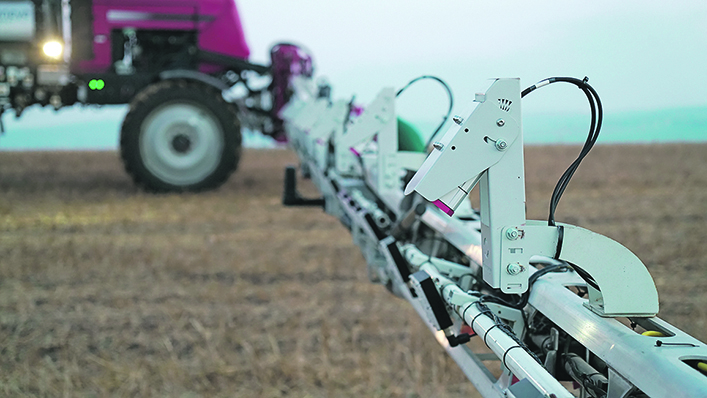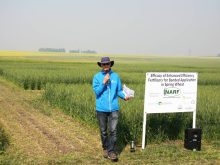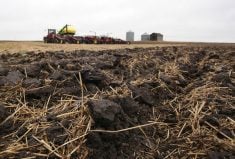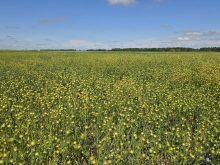The holy grail of autonomous nozzle control for picking weeds out of crop lineup has been green on green
Israel-based Greeneye Technology commercialized an artificial intelligence-based precision spraying system it claims can detect and spray weeds with 95.7 percent accuracy in corn and soy stands.
Its early adopter program in Nebraska, Iowa and Illinois is sold out but in 2023 the technology will be offered in more regions, including Canada.
The system will also be used to treat individual weeds in crops beyond soy and corn soon, said Nadav Bocher, chief executive officer of Greeneye Technology.
He said Greeneye will allow farmers to reduce the number of broadcast herbicide applications they apply, which will save them money and reduce the amount of herbicide applied off-target.
“What we’re looking to do as a company is to transition from this very wasteful practice (broadcast spraying) to a precise application, to spray only where it’s actually needed with our computer-vision based system,” Bocher said.
“Anywhere between 60 to 90 percent of herbicides can be saved by spraying them precisely only on the weeds, and that has a tremendous economic and profitability impact on farmers.”
In instances where producers want to use a broadcast application of a herbicide they can do so, and target individual weeds with a second product with sprayers that have two product streams.
“You’ll see no adoption if you won’t enable farmers to have the ability to spray residual herbicides on a broadcast basis and non-residual herbicides precisely on the weeds. That’s exactly why we built our dual spraying system, to enable farmers to do exactly that,” Bocher said.
He said the ability to target individual weeds enables farmers to use more expensive and effective chemistries that do not pencil in for broadcast applications.
“With resistance being a huge concern in the U.S., and also spreading north towards Canada, that’s a huge value that we offer and that also says something about the strategic collaboration we have with some of the largest crop protection manufacturers,” Bocher said.
Greeneye uses a combination of hardware and machine learning to identify and treat individual, in-crop weeds.
The company installs cameras on the sprayer’s booms slightly ahead of the nozzles that capture images at a rate of 40 frames per second.
This information is used by Greeneye’s proprietary datasets and algorithm to instantly calculate the location and amount of herbicide required to manage an individual weed.
Bocher said the system is sold as an aftermarket add-on and it is compatible with any of the sprayers currently being sold, as well as many sprayers currently parked in producers’ sheds.
Greeneye supports a working speed of more than 20 kilometres per hour.
The algorithms at the heart of Greeneye are unique data sets derived from millions of images from many different fields, crops, and growing regions including Canada, the United States and Australia.
The algorithms were originally built to detect weeds before crops were out of the ground, then the company enhanced it to pinpoint the weeds in the crop.
Bocher said system can help producers reduce non-residual herbicides by more than 78 percent.
“For farmers to actually adopt this technology, in many cases 90 percent accuracy (of in-crop weeds treated) is just not good enough because that means the 10 percent of the weeds will not be sprayed. That’s just a price a lot of farmers are just not willing to pay,” Bocher said.
“The average accuracy of our algorithms in real field conditions and commercial travel speed is 95.7 percent. The efficacy between Greeneye and broadcast spray is an almost identical performance when you use the same chemistry.”
The weed management system doesn’t require broadband or prepass data.
The massive data sets compiled of the high-resolution images can be used for multiple agronomic and farm management tasks beyond the application of crop protection products.
“Now what we’ve done is not just developed the ability to detect the weeds and to spray them, we can take it a step further and to classify the weeds down to a species level. So our algorithms are capable of recognizing more than 200 different species of weeds.”
This capability will enable the production of precise weed maps that will help farmers pick the right crop protection products.

Bocher said the ability to see each field in extremely high resolution will have many benefits, including knowing exactly how many plants there are on a field for crops such as corn.
“Another one is to provide early detection of diseases in the field. So, you can react very quickly. The same goes with micronutrients on the crop itself, understanding the needs of every individual plant in the field and finding some deficiencies with fertilizers and being much more effective with the way you apply them” he said.
It takes a significant effort to collect an enormous number of images and then use them to train algorithms when customizing the system for new environments.
This is where Greeneye appears to have an advantage over competing green on green systems being developed for the Canadian market.
Bocher lives in Quebec, and he said Greeneye has been collecting data from Canadian fields to train its algorithms for years.
“Canada has been a huge centre as far as collecting data and training our algorithms for those very specific field conditions, which are very different from what you see in the states,” Bocher said.
“We have this huge library of just Canadian field corn, soybean, wheat and barley. That’s already done, and we are continuing doing it, and in the 2023 season we expect to offer the system for the Canadian market.”


















